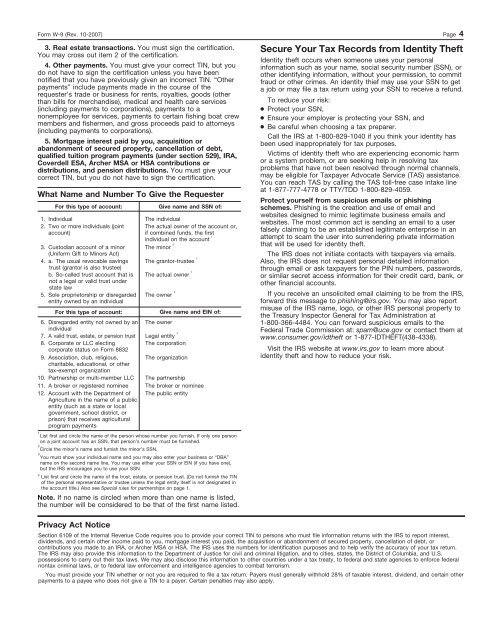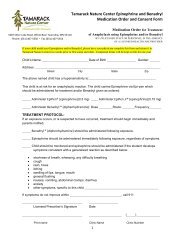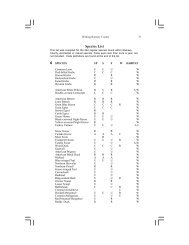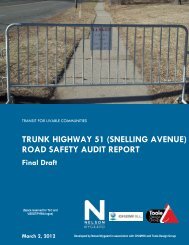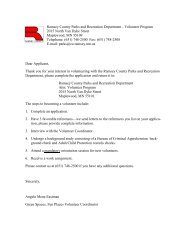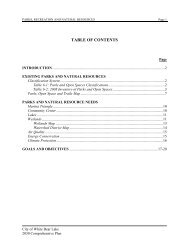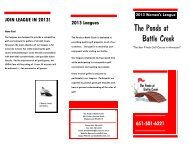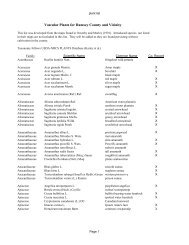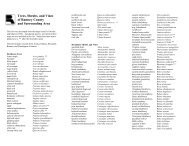W-9 Form - Ramsey County Parks and Recreation
W-9 Form - Ramsey County Parks and Recreation
W-9 Form - Ramsey County Parks and Recreation
Create successful ePaper yourself
Turn your PDF publications into a flip-book with our unique Google optimized e-Paper software.
<strong>Form</strong> W-9 (Rev. 10-2007) Page 4<br />
3. Real estate transactions. You must sign the certification.<br />
You may cross out item 2 of the certification.<br />
4. Other payments. You must give your correct TIN, but you<br />
do not have to sign the certification unless you have been<br />
notified that you have previously given an incorrect TIN. “Other<br />
payments” include payments made in the course of the<br />
requester’s trade or business for rents, royalties, goods (other<br />
than bills for merch<strong>and</strong>ise), medical <strong>and</strong> health care services<br />
(including payments to corporations), payments to a<br />
nonemployee for services, payments to certain fishing boat crew<br />
members <strong>and</strong> fishermen, <strong>and</strong> gross proceeds paid to attorneys<br />
(including payments to corporations).<br />
5. Mortgage interest paid by you, acquisition or<br />
ab<strong>and</strong>onment of secured property, cancellation of debt,<br />
qualified tuition program payments (under section 529), IRA,<br />
Coverdell ESA, Archer MSA or HSA contributions or<br />
distributions, <strong>and</strong> pension distributions. You must give your<br />
correct TIN, but you do not have to sign the certification.<br />
What Name <strong>and</strong> Number To Give the Requester<br />
For this type of account:<br />
1. Individual<br />
2. Two or more individuals (joint<br />
account)<br />
3. Custodian account of a minor<br />
(Uniform Gift to Minors Act)<br />
4. a. The usual revocable savings<br />
trust (grantor is also trustee)<br />
b. So-called trust account that is<br />
not a legal or valid trust under<br />
state law<br />
5. Sole proprietorship or disregarded<br />
entity owned by an individual<br />
For this type of account:<br />
6. Disregarded entity not owned by an<br />
individual<br />
7. A valid trust, estate, or pension trust<br />
8. Corporate or LLC electing<br />
corporate status on <strong>Form</strong> 8832<br />
9. Association, club, religious,<br />
charitable, educational, or other<br />
tax-exempt organization<br />
10. Partnership or multi-member LLC<br />
11. A broker or registered nominee<br />
12. Account with the Department of<br />
Agriculture in the name of a public<br />
entity (such as a state or local<br />
government, school district, or<br />
prison) that receives agricultural<br />
program payments<br />
Give name <strong>and</strong> SSN of:<br />
The individual<br />
The actual owner of the account or,<br />
if combined funds, the first<br />
1<br />
individual on the account<br />
The minor 2<br />
The grantor-trustee 1<br />
The actual owner 1<br />
The owner 3<br />
The owner<br />
Give name <strong>and</strong> EIN of:<br />
Legal entity 4<br />
The corporation<br />
The organization<br />
The partnership<br />
The broker or nominee<br />
The public entity<br />
1<br />
List first <strong>and</strong> circle the name of the person whose number you furnish. If only one person<br />
on a joint account has an SSN, that person’s number must be furnished.<br />
2<br />
Circle the minor’s name <strong>and</strong> furnish the minor’s SSN.<br />
3<br />
You must show your individual name <strong>and</strong> you may also enter your business or “DBA”<br />
name on the second name line. You may use either your SSN or EIN (if you have one),<br />
but the IRS encourages you to use your SSN.<br />
4<br />
List first <strong>and</strong> circle the name of the trust, estate, or pension trust. (Do not furnish the TIN<br />
of the personal representative or trustee unless the legal entity itself is not designated in<br />
the account title.) Also see Special rules for partnerships on page 1.<br />
Note. If no name is circled when more than one name is listed,<br />
the number will be considered to be that of the first name listed.<br />
Secure Your Tax Records from Identity Theft<br />
Identity theft occurs when someone uses your personal<br />
information such as your name, social security number (SSN), or<br />
other identifying information, without your permission, to commit<br />
fraud or other crimes. An identity thief may use your SSN to get<br />
a job or may file a tax return using your SSN to receive a refund.<br />
To reduce your risk:<br />
● Protect your SSN,<br />
● Ensure your employer is protecting your SSN, <strong>and</strong><br />
● Be careful when choosing a tax preparer.<br />
Call the IRS at 1-800-829-1040 if you think your identity has<br />
been used inappropriately for tax purposes.<br />
Victims of identity theft who are experiencing economic harm<br />
or a system problem, or are seeking help in resolving tax<br />
problems that have not been resolved through normal channels,<br />
may be eligible for Taxpayer Advocate Service (TAS) assistance.<br />
You can reach TAS by calling the TAS toll-free case intake line<br />
at 1-877-777-4778 or TTY/TDD 1-800-829-4059.<br />
Protect yourself from suspicious emails or phishing<br />
schemes. Phishing is the creation <strong>and</strong> use of email <strong>and</strong><br />
websites designed to mimic legitimate business emails <strong>and</strong><br />
websites. The most common act is sending an email to a user<br />
falsely claiming to be an established legitimate enterprise in an<br />
attempt to scam the user into surrendering private information<br />
that will be used for identity theft.<br />
The IRS does not initiate contacts with taxpayers via emails.<br />
Also, the IRS does not request personal detailed information<br />
through email or ask taxpayers for the PIN numbers, passwords,<br />
or similar secret access information for their credit card, bank, or<br />
other financial accounts.<br />
If you receive an unsolicited email claiming to be from the IRS,<br />
forward this message to phishing@irs.gov. You may also report<br />
misuse of the IRS name, logo, or other IRS personal property to<br />
the Treasury Inspector General for Tax Administration at<br />
1-800-366-4484. You can forward suspicious emails to the<br />
Federal Trade Commission at: spam@uce.gov or contact them at<br />
www.consumer.gov/idtheft or 1-877-IDTHEFT(438-4338).<br />
Visit the IRS website at www.irs.gov to learn more about<br />
identity theft <strong>and</strong> how to reduce your risk.<br />
Privacy Act Notice<br />
Section 6109 of the Internal Revenue Code requires you to provide your correct TIN to persons who must file information returns with the IRS to report interest,<br />
dividends, <strong>and</strong> certain other income paid to you, mortgage interest you paid, the acquisition or ab<strong>and</strong>onment of secured property, cancellation of debt, or<br />
contributions you made to an IRA, or Archer MSA or HSA. The IRS uses the numbers for identification purposes <strong>and</strong> to help verify the accuracy of your tax return.<br />
The IRS may also provide this information to the Department of Justice for civil <strong>and</strong> criminal litigation, <strong>and</strong> to cities, states, the District of Columbia, <strong>and</strong> U.S.<br />
possessions to carry out their tax laws. We may also disclose this information to other countries under a tax treaty, to federal <strong>and</strong> state agencies to enforce federal<br />
nontax criminal laws, or to federal law enforcement <strong>and</strong> intelligence agencies to combat terrorism.<br />
You must provide your TIN whether or not you are required to file a tax return. Payers must generally withhold 28% of taxable interest, dividend, <strong>and</strong> certain other<br />
payments to a payee who does not give a TIN to a payer. Certain penalties may also apply.


